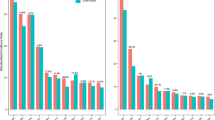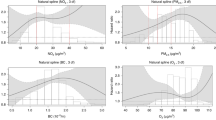Abstract
In epidemiologic studies of childhood cancer, environmental exposures are often assigned based on either residence at birth or diagnosis without considering the impact of residential mobility. Therefore, we evaluated residential mobility and exposure assignment differences to hazardous air pollutants between birth and diagnosis in children with a central nervous system (CNS) tumor. Children diagnosed with CNS tumors during 1995–2009 (N=1,196) were identified from the Texas Cancer Registry. Census tract-level estimates of 1,3-butadiene and benzene were used to assign quartiles of exposure based on the maternal residence at birth and the child’s residence at diagnosis. Overall, 64% of younger (0–4 years) children and 79% of older (5–14 years) children moved between birth and diagnosis. Using mixed-effects ordinal logistic regression, residence at diagnosis compared to birth did not result in a significant change in exposure assignment for younger children; however, older children were more likely to be placed in a lower 1,3-butadiene or benzene exposure quartile based on residence at diagnosis compared to birth (odds ratio (OR)=0.58, 95% confidence interval (CI)=0.45–0.76; OR=0.57, 95% CI=0.44–0.75, respectively). In conclusion, while the majority of children moved between birth and CNS tumor diagnosis, mobility did not significantly impact 1,3-butadiene and benzene exposure assessment in younger children.
This is a preview of subscription content, access via your institution
Access options
Subscribe to this journal
Receive 6 print issues and online access
$259.00 per year
only $43.17 per issue
Buy this article
- Purchase on Springer Link
- Instant access to full article PDF
Prices may be subject to local taxes which are calculated during checkout
Similar content being viewed by others
References
Boothe VL, Boehmer TK, Wendel AM, Yip FY . Residential traffic exposure and childhood leukemia: a systematic review and meta-analysis. Am J Prev Med 2014; 46: 413–422.
Raaschou-Nielsen O, Reynolds P . Air pollution and childhood cancer: a review of the epidemiological literature. Int J Cancer 2006; 118: 2920–2929.
Anderson LM, Diwan BA, Fear NT, Roman E . Critical windows of exposure for children's health: cancer in human epidemiological studies and neoplasms in experimental animal models. Environ Health Perspect 2000; 108 (Suppl 3): 573–594.
Crosignani P, Tittarelli A, Borgini A, Codazzi T, Rovelli A, Porro E et al. Childhood leukemia and road traffic: a population-based case-control study. Int J Cancer 2004; 108: 596–599.
Danysh HE, Mitchell LE, Zhang K, Scheurer ME, Lupo PJ . Traffic-related air pollution and the incidence of childhood central nervous system tumors: Texas, 2001-2009. Pediatr Blood Cancer 2015; 62: 1572–1578.
Heck JE, Park AS, Qiu J, Cockburn M, Ritz B . An exploratory study of ambient air toxics exposure in pregnancy and the risk of neuroblastoma in offspring. Environ Res 2013; 127: 1–6.
Heck JE, Park AS, Qiu J, Cockburn M, Ritz B . Risk of leukemia in relation to exposure to ambient air toxics in pregnancy and early childhood. Int J Hyg Environ Health 2014; 217: 662–668.
Heck JE, Park AS, Qiu J, Cockburn M, Ritz B . Retinoblastoma and ambient exposure to air toxics in the perinatal period. J Expo Sci Environ Epidemiol 2015; 25: 182–186.
Heck JE, Wu J, Lombardi C, Qiu J, Meyers TJ, Wilhelm M et al. Childhood cancer and traffic-related air pollution exposure in pregnancy and early life. Environ Health Perspect 2013; 121: 1385–1391.
Raaschou-Nielsen O, Hertel O, Thomsen BL, Olsen JH . Air pollution from traffic at the residence of children with cancer. Am J Epidemiol 2001; 153: 433–443.
U.S. Environmental Protection Agency. Technology Transfer Network: Air Toxics Web Site. Retrieved 7 August 2013, from http://www.epa.gov/ttnatw01/allabout.html.
International Agency for Research on Cancer. IARC monographs on the evaluation of carcinogenic risks to humans. Volume 97. 1,3-butadiene, ethylene oxide and vinyl halides (vinyl fluoride, vinyl chloride and vinyl bromide). IARC Monogr Eval Carcinog Risks Hum 2008; 97: 3–471.
International Agency for Research on Cancer. IARC monographs on the evaluation of carcinogenic risks to humans. Volume 100 F. Chemical agents and related occupations. IARC Monogr Eval Carcinog Risks Hum 2012; 100: 9–562.
U.S. Environmental Protection Agency. Toxics Release Inventory (TRI) Explorer (2012 Dataset) [Internet database]. Retrieved 15 February 2015, from http://www.epa.gov/triexplorer.
Steliarova-Foucher E, Stiller C, Lacour B, Kaatsch P . International Classification of Childhood Cancer, third edition. Cancer 2005; 103: 1457–1467.
U.S. Census Bureau. Geographic Terms and Concepts - Census Tract. Retrieved 15 October 2014, from https://www.census.gov/geo/reference/gtc/gtc_ct.html.
U.S. Environmental Protection Agency. 2002 National-Scale Air Toxics Assessment. Retrieved 16 July 2013, from http://www.epa.gov/ttn/atw/nata2002/index.html.
Rosenbaum AS, Axelrad DA, Woodruff TJ, Wei YH, Ligocki MP, Cohen JP . National estimates of outdoor air toxics concentrations. J Air Waste Manag Assoc 1999; 49: 1138–1152.
U.S. Environmental Protection Agency. The ASPEN Model. Retrieved 2 June 2013, from http://www.epa.gov/ttn/atw/nata/aspen.html.
Lupo PJ, Symanski E, Chan W, Mitchell LE, Waller DK, Canfield MA et al. Differences in exposure assignment between conception and delivery: the impact of maternal mobility. Paediatr Perinat Epidemiol 2010; 24: 200–208.
Sheu CF . Fitting mixed-effects models for repeated ordinal outcomes with the NLMIXED procedure. Behav Res Methods Instrum Comput 2002; 34: 151–157.
Woodruff TJ, Parker JD, Kyle AD, Schoendorf KC . Disparities in exposure to air pollution during pregnancy. Environ Health Perspect 2003; 111: 942–946.
Gwynn RC, Thurston GD . The burden of air pollution: impacts among racial minorities. Environ Health Perspect 2001; 109 (Suppl 4): 501–506.
Linder SH, Marko D, Sexton K . Cumulative cancer risk from air pollution in Houston: disparities in risk burden and social disadvantage. Environ Sci Technol 2008; 42: 4312–4322.
Urayama KY, Von Behren J, Reynolds P, Hertz A, Does M, Buffler PA . Factors associated with residential mobility in children with leukemia: implications for assigning exposures. Ann Epidemiol 2009; 19: 834–840.
Krieger N, Williams DR, Moss NE . Measuring social class in US public health research: concepts, methodologies, and guidelines. Annu Rev Public Health 1997; 18: 341–378.
Subramanian SV, Chen JT, Rehkopf DH, Waterman PD, Krieger N . Comparing individual- and area-based socioeconomic measures for the surveillance of health disparities: a multilevel analysis of Massachusetts births, 1989-1991. Am J Epidemiol 2006; 164: 823–834.
Johnson KJ, Cullen J, Barnholtz-Sloan JS, Ostrom QT, Langer CE, Turner MC et al. Childhood brain tumor epidemiology: a brain tumor epidemiology consortium review. Cancer Epidemiol Biomarkers Prev 2014; 23: 2716–2736.
Savitz DA, Feingold L . Association of childhood cancer with residential traffic density. Scand J Work Environ Health 1989; 15: 360–363.
Lupo PJ, Symanski E, Waller DK, Chan W, Langlois PH, Canfield MA et al. Maternal exposure to ambient levels of benzene and neural tube defects among offspring: Texas, 1999-2004. Environ Health Perspect 2011; 119: 397–402.
Bell ML, Belanger K . Review of research on residential mobility during pregnancy: consequences for assessment of prenatal environmental exposures. J Expo Sci Environ Epidemiol 2012; 22: 429–438.
Garcia E, Hurley S, Nelson DO, Gunier RB, Hertz A, Reynolds P . Evaluation of the agreement between modeled and monitored ambient hazardous air pollutants in California. Int J Environ Health Res 2014; 24: 363–377.
Payne-Sturges DC, Burke TA, Breysse P, Diener-West M, Buckley TJ . Personal exposure meets risk assessment: a comparison of measured and modeled exposures and risks in an urban community. Environ Health Perspect 2004; 112: 589–598.
Lupo PJ, Symanski E . A comparative analysis of modeled and monitored ambient hazardous air pollutants in Texas: a novel approach using concordance correlation. J Air Waste Manag Assoc 2009; 59: 1278–1286.
Reynolds P, Von Behren J, Gunier RB, Goldberg DE, Hertz A, Smith DF . Childhood cancer incidence rates and hazardous air pollutants in California: an exploratory analysis. Environ Health Perspect 2003; 111: 663–668.
Whitworth KW, Symanski E, Coker AL . Childhood lymphohematopoietic cancer incidence and hazardous air pollutants in southeast Texas, 1995-2004. Environ Health Perspect 2008; 116: 1576–1580.
Woodruff TJ, Grillo J, Schoendorf KC . The relationship between selected causes of postneonatal infant mortality and particulate air pollution in the United States. Environ Health Perspect 1997; 105: 608–612.
U.S. Environmental Protection Agency. National Air Toxics Assessments. Retrieved 17 July 2014, from http://www.epa.gov/nata/.
Sexton K, Linder SH, Marko D, Bethel H, Lupo PJ . Comparative assessment of air pollution-related health risks in Houston. Environ Health Perspect 2007; 115: 1388–1393.
Acknowledgements
We thank the personnel at the Texas Cancer Registry and the Center for Health Statistics at the Texas Department of State Health Services. This work was supported in part by the Kurt Groten Family Research Scholars Award (Philip J. Lupo).
Author information
Authors and Affiliations
Corresponding author
Ethics declarations
Competing interests
The authors declare no conflict of interest.
Additional information
Supplementary Information accompanies the paper on the Journal of Exposure Science and Environmental Epidemiology website
Supplementary information
Rights and permissions
About this article
Cite this article
Danysh, H., Mitchell, L., Zhang, K. et al. Differences in environmental exposure assignment due to residential mobility among children with a central nervous system tumor: Texas, 1995–2009. J Expo Sci Environ Epidemiol 27, 41–46 (2017). https://doi.org/10.1038/jes.2015.63
Received:
Revised:
Accepted:
Published:
Issue Date:
DOI: https://doi.org/10.1038/jes.2015.63
Keywords
This article is cited by
-
1,3-Butadiene: a ubiquitous environmental mutagen and its associations with diseases
Genes and Environment (2022)
-
Predictors of residential mobility and its impact on air pollution exposure among children diagnosed with early childhood leukemia
Journal of Exposure Science & Environmental Epidemiology (2019)



